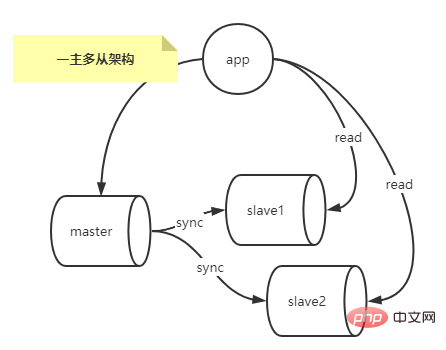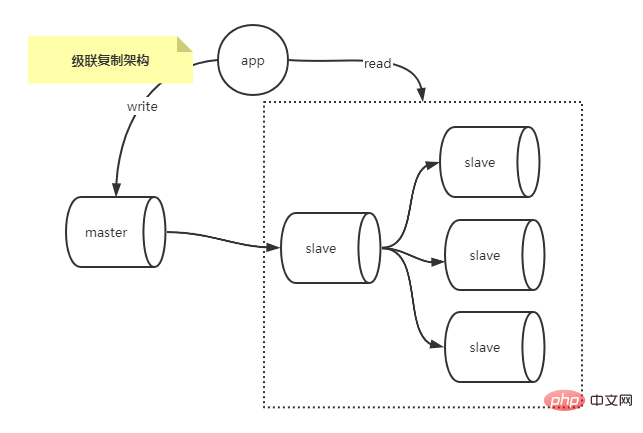
This article brings you relevant knowledge about mysql, which mainly introduces related issues about replication architecture, including master-slave replication architecture, cascade replication architecture, and multi-master-slave replication. The construction of the architecture, etc., I hope it will be helpful to everyone.

Recommended learning: mysql video tutorial
In actual application scenarios , More than 90% of MySQL replication is an architectural model in which one Master replicates to one or more Slaves.
In scenarios where the main library read request pressure is very high, you can configure the one-master multi-slave replication architecture to achieve read-write separation, and separate a large number of data that do not have particularly high real-time requirements. Read requests are distributed to multiple slave libraries through load balancing (read requests with high real-time requirements can be read from the master library), reducing the reading pressure on the master library, as shown in the figure below.

Disadvantages:
Since the master needs to be shut down for routine maintenance, it is necessary to convert a slave into the master. Which one to choose is a problem?
When a slave becomes a master, there will be inconsistencies between the data of the current master and the previous master, and the previous master did not save the binlog file and pos location of the current master node.
The multi-master replication architecture solves the single point of failure problem of the master in the single-master multi-slave replication architecture.

You can use a third-party tool, such as keepalived, to easily achieve IP drift, so that master downtime for maintenance will not affect write operations.
One master and many slaves. If there are too many slaves, the I/O pressure and network pressure of the master library will increase with the increase of slave libraries, because each The slave library will have an independent BINLOG Dump thread on the master library to send events, and the cascade replication architecture solves the additional I/O and network pressure on the master library in the scenario of one master and multiple slaves.
As shown below.

Compared with the one-master and multiple-slave architecture, cascade replication only copies from the master database to a small number of slave databases, and other slave databases then copy from these few slave databases. Copy the data, thus reducing the pressure on the main database Master.
Of course, there are also disadvantages: MySQL’s traditional replication is asynchronous. In the cascade replication scenario, the data in the master database has to undergo two replications before reaching other slave databases. The delay during this period is compared with the one-master and multiple-slave replication scenario. It's a big deal if it only goes through one copy next time.
You can reduce the delay of cascade replication by selecting the table engine as BLACKHOLE on the secondary slave. As the name suggests, the BLACKHOLE engine is a "black hole" engine. The data written to the BLACKHOLE table will not be written to the disk. The BLACKHOLE table is always an empty table. INSERT, UPDATE, and DELETE operations only record events in the BINLOG.
The following demonstrates the BLACKHOLE engine:
mysql> CREATE TABLE `user` (
-> `id` int NOT NULL AUTO_INCREMENT PRIMARY KEY,
-> `name` varchar(255) NOT NULL DEFAULT '',
-> `age` tinyint unsigned NOT NULL DEFAULT 0
-> )ENGINE=BLACKHOLE charset=utf8mb4;Query OK, 0 rows affected (0.00 sec)mysql> INSERT INTO `user` (`name`,`age`) values("itbsl", "26");Query OK, 1 row affected (0.00 sec)mysql> select * from user;Empty set (0.00 sec)As you can see, there is no data in the user table whose storage engine is BLACKHOLE.
Combining multi-master and cascade replication architecture solves the problem of single-point master and the problem of slave cascade delay.

Host planning:
Configuration file my.cnf:
$ cat /home/mysql/docker-data/3315/conf/my.cnf [mysqld] character_set_server=utf8 init_connect='SET NAMES utf8' symbolic-links=0 lower_case_table_names=1 server-id=1403314 log-bin=mysql-bin binlog-format=ROW auto_increment_increment=2 # 几个主库,这里就配几 auto_increment_offset=1 # 每个主库的偏移量需要不一致 gtid_mode=ON enforce-gtid-consistency=true binlog-do-db=order # 要同步的数据库
Start docker:
$ docker run --name mysql3314 -p 3314:3306 --privileged=true -ti -e MYSQL_ROOT_PASSWORD=root -e MYSQL_DATABASE=order -e MYSQL_USER=user -e MYSQL_PASSWORD=pass -v /home/mysql/docker-data/3314/conf:/etc/mysql/conf.d -v /home/mysql/docker-data/3314/data/:/var/lib/mysql -v /home/mysql/docker-data/3314/logs/:/var/log/mysql -d mysql:5.7
Add with To the copied user and authorize:
mysql> GRANT REPLICATION SLAVE,FILE,REPLICATION CLIENT ON *.* TO 'repluser'@'%' IDENTIFIED BY '123456'; Query OK, 0 rows affected, 1 warning (0.01 sec) mysql> FLUSH PRIVILEGES; Query OK, 0 rows affected (0.01 sec)
Turn on synchronization master1 (the user here comes from master2):
mysql> change master to master_host='172.23.252.98',master_port=3315,master_user='repluser',master_password='123456',master_auto_position=1; Query OK, 0 rows affected, 2 warnings (0.03 sec) mysql> start slave; Query OK, 0 rows affected (0.00 sec)
The configuration of master2 is similar to master1.
The main difference is that there is an attribute in my.cnf that needs to be inconsistent:
auto_increment_offset=2 # 每个主库的偏移量需要不一致
Test:
Create a table in master2 and add data:
mysql> create table t_order(id int primary key auto_increment, name varchar(20));
Query OK, 0 rows affected (0.01 sec)
mysql> insert into t_order(name) values("A");
Query OK, 1 row affected (0.01 sec)
mysql> insert into t_order(name) values("B");
Query OK, 1 row affected (0.00 sec)
mysql> select * from t_order;
+----+------+
| id | name |
+----+------+
| 2 | A |
| 4 | B |
+----+------+
2 rows in set (0.00 sec)It can be found that the step size of id in master2 is 2, and it starts to increase from 2.
Then query the data in master1 and add:
mysql> select * from t_order;
+----+------+
| id | name |
+----+------+
| 2 | A |
| 4 | B |
+----+------+
2 rows in set (0.00 sec)
mysql> insert into t_order(name) values("E");
Query OK, 1 row affected (0.00 sec)
mysql> select * from t_order;
+----+------+
| id | name |
+----+------+
| 2 | A |
| 4 | B |
| 5 | E |
+----+------+
3 rows in set (0.00 sec)You can find that the step size of id in master1 is 2, and it starts to increase from 1. Then query in master2 and you can find that the id is 5. The data shows that there is no problem with the master-master replication configuration.
Why are the offsets of the id increment in the two masters inconsistent? When the two masters receive the insertion request at the same time, it can ensure that the ID does not conflict. In fact, this can only ensure that the inserted data does not conflict, but cannot guarantee the data inconsistency caused by deletion and modification.
So in actual application scenarios, only one master can be exposed to the client to ensure data consistency.

这里借助keepalived来对上面的多主复制架构改造来实现MySQL的高可用。
keepalived的安装:
$ sudo apt-get install -y keepalived
keepalived.conf
$ cat /etc/keepalived/keepalived3314.conf! Configuration File for keepalived#简单的头部,这里主要可以做邮件通知报警等的设置,此处就暂不配置了;global_defs {
#notificationd LVS_DEVEL}#预先定义一个脚本,方便后面调用,也可以定义多个,方便选择;vrrp_script chk_haproxy {
script "/etc/keepalived/chkmysql.sh" #具体脚本路径
interval 2 #脚本循环运行间隔}#VRRP虚拟路由冗余协议配置vrrp_instance VI_1 { #VI_1 是自定义的名称;
state BACKUP #MASTER表示是一台主设备,BACKUP表示为备用设备【我们这里因为设置为开启不抢占,所以都设置为备用】
nopreempt #开启不抢占
interface eth0 #指定VIP需要绑定的物理网卡
virtual_router_id 11 #VRID虚拟路由标识,也叫做分组名称,该组内的设备需要相同
priority 130 #定义这台设备的优先级 1-254;开启了不抢占,所以此处优先级必须高于另一台
advert_int 1 #生存检测时的组播信息发送间隔,组内一致
authentication { #设置验证信息,组内一致
auth_type PASS #有PASS 和 AH 两种,常用 PASS
auth_pass asd #密码
}
virtual_ipaddress {
172.23.252.200 #指定VIP地址,组内一致,可以设置多个IP
}
track_script { #使用在这个域中使用预先定义的脚本,上面定义的
chk_haproxy }
#notify_backup "/etc/init.d/haproxy restart" #表示当切换到backup状态时,要执行的脚本
#notify_fault "/etc/init.d/haproxy stop" #故障时执行的脚本}/etc/keepalived/chkmysql.sh
$ cat /etc/keepalived/chkmysql.s.sh#!/bin/bashmysql -uroot -proot -P 3314 -e "show status;" > /dev/null 2>&1if [ $? == 0 ];then echo "$host mysql login successfully" exit 0else echo "$host login failed" killall keepalived exit 2fi
推荐学习:mysql视频教程
The above is the detailed content of Complete mastery of MySQL replication architecture. For more information, please follow other related articles on the PHP Chinese website!